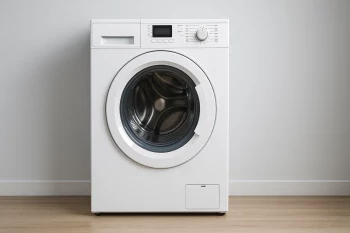Okay, real talk - I spent way too many years cramming bedsheets into a tiny washing machine that clearly wasn't up for the job. Don't make my mistake! Choosing the right washing machine capacity isn't just about fitting it in your laundry room. It's about actually being able to wash your stuff properly without wanting to throw the whole machine out the window.
Here's everything I wish someone had told me before I bought my first (and second, and third) washing machine.
What Does Washing Machine Capacity Actually Mean?
So washing machine capacity is measured in cubic feet - basically how much space you've got inside the drum. But here's the thing that confused me for ages: manufacturers love to throw around these numbers without telling you what they actually mean in real life.
A "large capacity" machine might sound impressive until you realize your king-size comforter still won't fit properly. The capacity tells you about volume, but it doesn't tell you about the shape of the drum or how the clothes actually move around during the wash cycle.
Breaking Down Washing Machine Sizes
Compact Washers (2.3-2.5 cu ft)
These little guys are perfect if you're living in a tiny apartment or just don't have much laundry. I had one in my first studio, and honestly? It was fine for someone who basically lived in jeans and t-shirts.
What fits: About 6 pounds of laundry, which translates to roughly 6-8 casual outfits or 2-3 towels. Think of it as enough for one person who does laundry pretty regularly.
Reality check: You'll be doing laundry constantly if you have more than basic clothing needs. Forget about washing bulky items like comforters or even thick sweatshirts.
Standard/Medium Capacity (3.1-4.0 cu ft)
This is where most people land, and for good reason. These machines hit that sweet spot between size and functionality that works for a lot of households.
What fits: Around 8-12 pounds of laundry. You can wash about 10-14 everyday items, or roughly a week's worth of clothes for one person, maybe 4-5 days for a couple.
Perfect for: Small families, couples, or anyone who likes to do laundry once or twice a week instead of constantly.
Large Capacity (4.1-5.0 cu ft)
Now we're talking! These are the workhorses that can handle bigger loads without breaking a sweat.
What fits: 12-15 pounds of laundry. You're looking at 16-20 clothing items, or enough to wash bedding for a queen-size bed along with some clothes.
Game changer moment: This is where you can actually fit a comforter without it looking like you're trying to stuff a sleeping bag into a lunch box.
Extra Large Capacity (5.1+ cu ft)
These are the monsters of the washing machine world. If you've got a big family or just really hate doing laundry frequently, this might be your new best friend.
What fits: 15+ pounds of laundry. We're talking 20+ clothing items, or the ability to wash king-size bedding with room to spare.
Heads up: These machines are physically huge and will eat up your laundry room space. Make sure you measure first!
How to Figure Out What Size You Actually Need
Count Your People (And Their Laundry Habits)
Here's my rough formula that's worked pretty well:
- 1 person = 2.3-3.1 cu ft (unless you're a clothes hoarder like my sister)
- 2 people = 3.1-4.0 cu ft
- 3-4 people = 4.1-5.0 cu ft
- 5+ people = 5.1+ cu ft (and maybe invest in a really good laundry detergent)
But honestly, think about your actual lifestyle. Do you work from home in pajamas most days? You probably don't need as much capacity. Got kids who change clothes three times a day and play in mud? Size up.
Consider Your Washing Frequency
I'm a "do laundry when I run out of clean underwear" person, so I needed more capacity than someone who does a load every other day. If you're the type who likes to get all the laundry done in one weekend session, go bigger. If you don't mind throwing in a load whenever, you can get away with smaller.
Think About Bulky Items
This is where I messed up with my first machine. I didn't think about comforters, sleeping bags, winter coats, or even just really fluffy towels. If you want to wash these things at home instead of dragging them to a laundromat, make sure your machine can actually handle them.
Common Capacity Mistakes (That I've Definitely Made)
Going Too Small to Save Money
Penny wise, pound foolish - that's what my grandmother would say. A smaller machine might cost less upfront, but you'll spend more on water and electricity doing twice as many loads. Plus, your time is worth something too.
Assuming Bigger Is Always Better
I thought this once and ended up with a machine that barely fit through my door and made my already-small laundry room feel like a closet. Also, if you're usually washing small loads, a huge machine wastes water and energy.
Forgetting About Installation Space
Measure your space! Not just where the machine will sit, but also factor in opening the lid or door, plus space to move around. I learned this lesson when I had to return a perfectly good washer because it wouldn't fit through my hallway.
Not Considering the Matching Dryer
If you're buying a washer and dryer set, make sure they're balanced capacity-wise. Having a huge washer with a tiny dryer means you'll be doing two dryer cycles for every wash load. Been there, hated that.
What Different Loads Actually Look Like
Let me give you some real-world examples because "12 pounds of laundry" doesn't mean much until you see it:
Small Load (6-8 lbs): A week's worth of underwear and socks, a few t-shirts, maybe a pair of jeans. Basically what fits in a normal laundry basket without stuffing.
Medium Load (8-12 lbs): Two people's casual clothes for 3-4 days, or one person's laundry for a week including a few heavier items like sweatshirts or jeans.
Large Load (12-16 lbs): A family's worth of everyday clothes, or bed sheets plus some clothing, or several towels and washcloths.
Extra Large Load (16+ lbs): King-size comforter, or enough clothes to avoid doing laundry for way too long (we've all been there).
Special Considerations
High-Efficiency (HE) Machines
Most newer machines are HE, which is great for water and energy savings. But they work differently than old-school machines. They use less water and rely more on the clothes tumbling around to get clean. This means capacity becomes even more important - overload an HE machine and your clothes won't get clean.
Top Load vs Front Load Capacity
Top loaders usually give you a bit more usable space because you're not losing room to the door mechanism. But front loaders often clean better and are gentler on clothes. It's a trade-off.
Apartment Living
If you're in an apartment, you might be stuck with whatever connections you have available. Compact washers can hook up to kitchen sinks if needed, which opens up possibilities if you don't have traditional laundry hookups.
Making the Final Decision
Here's my advice after going through this process more times than I'd like to admit: think about your most annoying laundry day scenario. Is it stuffing a comforter into a machine that's clearly too small? Running out of clean work clothes because you can't fit enough in one load? Having to spend your entire Sunday doing laundry?
Pick the machine size that solves your biggest laundry headache. For most people, that's going to be in the 4.0-4.5 cu ft range - big enough to handle most everything you throw at it, but not so massive that it takes over your space.
And here's something nobody tells you: it's better to slightly oversize than undersize. You can always wash smaller loads in a bigger machine, but you can't magically make a small machine bigger when you need it.
The Bottom Line
Washing machine capacity isn't just about numbers on a spec sheet. It's about making your life easier and actually being able to wash the stuff you need to wash. Take some time to think about your real laundry habits, measure your space, and don't be afraid to go a little bigger than you think you need.
Trust me, your future self will thank you when you can actually fit that winter comforter in the machine instead of dragging it to the laundromat.





